Exploring Habitat Quality Dynamics in an Equatorial Andean Basin Under Scenarios of Land Use Change
Abstract
:1. Introduction
2. Materials and Methods
2.1. Study Zone
2.2. InVEST Model for Habitat Quality Modelling
- Finally, the model uses the sensitivity of the habitat type to threats to calculate the degradation in a cell (Sjr that varies between 0 and 1). Values close to 1 indicate greater sensitivity. This specific sensitivity for the species group is based on ecological principles for conservation.
2.3. Input Data for the Model
2.3.1. Land Use and Land Cover (LULC)
2.3.2. Thread and Sensitivity Factors
2.3.3. Habitat Quality Analysis
3. Results and Discussion
3.1. Spatial–Temporal Evolution of the HQI
3.2. The HQI According to the Different Land Uses
3.3. Policy Implications
3.4. Limitations, Uncertainty, and Outlook
4. Conclusions
Author Contributions
Funding
Data Availability Statement
Acknowledgments
Conflicts of Interest
References
- Sandhu, H.; Zhang, W.; Meinzen-Dick, R.; ElDidi, H.; Perveen, S.; Sharma, J.; Kaur, J.; Priyadarshini, P. Valuing ecosystem services provided by land commons in India: Implications for research and policy. Environ. Res. Lett. 2023, 18, 013001. [Google Scholar] [CrossRef]
- Šmid Hribar, M.; Hori, K.; Urbanc, M.; Saito, O.; Zorn, M. Evolution and new potentials of landscape commons: Insights from Japan and Slovenia. Ecosyst. Serv. 2023, 59, 101499. [Google Scholar] [CrossRef]
- Millennium Ecosystem Assessment. Ecosystems and Human Well-Being: Synthesis; Island Press: Washington, DC, USA, 2005. [Google Scholar]
- Garcia, V.; Márquez, C.; Rodríguez, M.; Orozco, J.; Aguilar, C.; Ríos, A. Páramo Ecosystems in Ecuador’s Southern Region: Conservation State and Restoration. Agronomy 2020, 10, 1922. [Google Scholar] [CrossRef]
- Buonocore, E.; Grande, U.; Franzese, P.P.; Russo, G.F. Trends and evolution in the concept of marine ecosystem services: An overview. Water 2021, 13, 2060. [Google Scholar] [CrossRef]
- Zhang, Z.; Li, T.; Li, L.; Li, S.; Rong, Y.; Bao, R.; Fu, X.; Tang, M.; Wu, G. Integrating ecosystem service importance and ecological sensitivity to identify priority areas for ecological conservation and restoration in Miyun Reservoir Basin. Int. J. Sustain. Dev. World Ecol. 2023, 30, 925–937. [Google Scholar] [CrossRef]
- Ma, L.; Zhu, Z.; Li, S.; Li, J. Analysis of spatial and temporal changes in human interference in important ecological function areas in China: The Gansu section of Qilian Mountain National Park as an example. Environ. Monit. Assess. 2023, 195, 1029. [Google Scholar] [CrossRef]
- Duan, X.; Chen, Y.; Wang, L.; Zheng, G.; Liang, T. The impact of land use and land cover changes on the landscape pattern and ecosystem service value in Sanjiangyuan region of the Qinghai-Tibet Plateau. J. Environ. Manag. 2023, 325, 116539. [Google Scholar] [CrossRef]
- Li, S.; Congmou, Z.; Li, Y.; Dong, B.; Tan, K.; Deng, X. Agricultural space function transitions in rapidly urbanizing areas and their impacts on habitat quality: An urban–Rural gradient study. Environ. Impact Assess. Rev. 2023, 99, 107019. [Google Scholar] [CrossRef]
- Liu, Y.; Yuan, X.; Li, J.; Qian, K.; Yan, W.; Yang, X.; Ma, X. Trade-offs and synergistic relationships of ecosystem services under land use change in Xinjiang from 1990 to 2020: A Bayesian network analysis. Sci. Total Environ. 2023, 858, 160015. [Google Scholar] [CrossRef]
- Admasu, S.; Yeshitela, K.; Argaw, M. Assessing habitat quality using the InVEST model in the Dire and Legedadi watersheds, central highland of Ethiopia: Implication for watershed management. Sustain. Environ. 2023, 9, 2242137. [Google Scholar] [CrossRef]
- Li, Y.; Liu, W.; Feng, Q.; Zhu, M.; Yang, L.; Zhang, J.; Yin, X. The role of land use change in affecting ecosystem services and the ecological security pattern of the Hexi Regions, Northwest China. Sci. Total Environ. 2023, 855, 158940. [Google Scholar] [CrossRef] [PubMed]
- Xie, X.; Zhu, Q. Research on the Impact of Urban Expansion on Habitat Quality in Chengdu. Sustainability 2023, 15, 6271. [Google Scholar] [CrossRef]
- Alaniz, A.J.; Carvajal, M.A.; Fierro, A.; Vergara-Rodríguez, V.; Toledo, G.; Ansaldo, D.; Moreira-Arce, D.; Rojas-Osorio, A.; Vergara, P.M. Remote-sensing estimates of forest structure and dynamics as indicators of habitat quality for Magellanic woodpeckers. Ecol. Indic. 2021, 126, 107634. [Google Scholar] [CrossRef]
- Zhu, C.; Zhang, X.; Zhou, M.; He, S.; Gan, M.; Yang, L.; Wang, K. Impacts of urbanization and landscape pattern on habitat quality using OLS and GWR models in Hangzhou, China. Ecol. Indic. 2020, 117, 106654. [Google Scholar] [CrossRef]
- Wu, P.; Dai, P.; Wang, M.; Feng, S.; Olhnuud, A.; Xu, H.; Li, X.; Liu, Y. Improving Habitat Quality at the Local and Landscape Scales Increases Wild Bee Assemblages and Associated Pollination Services in Apple Orchards in China. Front. Ecol. Evol. 2021, 9, 621469. [Google Scholar] [CrossRef]
- Ji, X.; Sun, Y.; Guo, W.; Zhao, C.; Li, K. Land use and habitat quality change in the Yellow River Basin: A perspective with different CMIP6-based scenarios and multiple scales. J. Environ. Manag. 2023, 345, 118729. [Google Scholar] [CrossRef]
- Mohammadyari, F.; Tavakoli, M.; Zarandian, A.; Abdollahi, S. Optimization land use based on multi-scenario simulation of ecosystem service for sustainable landscape planning in a mixed urban–Forest watershed. Ecol. Modell. 2023, 483, 110440. [Google Scholar] [CrossRef]
- Kovaleva, N. Ecology: Life in the “Unstable Biosphere”. In Reconsidering the Limits to Growth: A Report to the Russian Association of the Club of Rome; Springer: Berlin/Heidelberg, Germany, 2023; pp. 71–95. [Google Scholar]
- Mulinge, J. Effects of Environmental Change on Species Diversity. Int. J. Biol. 2023, 3, 43–53. [Google Scholar] [CrossRef]
- Jones, R.; Wilson, R.J.; Bourn, N.A.D.; Maclean, I.M.D. Patchy range retractions in response to climate change and implications for terrestrial species conservation. Landsc. Ecol. 2023, 38, 3003–3025. [Google Scholar] [CrossRef]
- Vasiliev, D.; Greenwood, S. The role of landscape connectivity in maintaining pollinator biodiversity needs reconsideration. Biodivers. Conserv. 2023, 32, 3765–3790. [Google Scholar] [CrossRef]
- Yang, Y. Evolution of habitat quality and association with land-use changes in mountainous areas: A case study of the Taihang Mountains in Hebei Province, China. Ecol. Indic. 2021, 129, 107967. [Google Scholar] [CrossRef]
- Xie, Z.X.; Zhang, B.; Shi, Y.T.; Zhang, X.Y.; Sun, Z.X. Changes and protections of urban habitat quality in Shanghai of China. Sci. Rep. 2023, 13, 10976. [Google Scholar] [CrossRef] [PubMed]
- Capriolo, A.; Boschetto, R.G.; Mascolo, R.A.; Balbi, S.; Villa, F. Biophysical and economic assessment of four ecosystem services for natural capital accounting in Italy. Ecosyst. Serv. 2020, 46, 101207. [Google Scholar] [CrossRef]
- Villa, F.; Ceroni, M.; Bagstad, K.; Johnson, G.; Krivov, S. ARIES (ARtificial Intelligence for Ecosystem Services): A New Tool for Ecosystem Services Assessment, Planning, and Valuation. In Proceedings of the 11th Annual BIOECON Conference on Economic Instruments to Enhance the Conservation and Sustainable Use of Biodiversity, Venice, Italy, 21–22 September 2009; pp. 1–10. Available online: http://scholar.google.com/scholar?hl=en&btnG=Search&q=intitle:ARIES+(+ARtificial+Intelligence+for+Ecosystem+Services+):+a+new+tool+for+ecosystem+services+assessment+,+planning+,+and+valuation+.#0 (accessed on 21 October 2024).
- Pei, X.; Yang, L.; Ji, W.; Cheng, X.; Lu, X. Global validation and comparison of MODIS DT and POLDER-3 GRASP aerosol products over ocean. Atmos. Res. 2023, 281, 106480. [Google Scholar] [CrossRef]
- Sherrouse, B.C.; Semmens, D.J.; Ancona, Z.H. Social Values for Ecosystem Services (SolVES): Open-source spatial modeling of cultural services. Environ. Model. Softw. 2022, 148, 105259. [Google Scholar] [CrossRef]
- Boumans, R.; Roman, J.; Altman, I.; Kaufman, L. The multiscale integrated model of ecosystem services (MIMES): Simulating the interactions of coupled human and natural systems. Ecosyst. Serv. 2015, 12, 30–41. [Google Scholar] [CrossRef]
- Wang, J.; Wu, Y.; Gou, A. Habitat quality evolution characteristics and multi-scenario prediction in Shenzhen based on PLUS and InVEST models. Front. Environ. Sci. 2023, 11, 1146347. [Google Scholar] [CrossRef]
- Zhao, J.; Shao, Z.; Xia, C.; Fang, K.; Chen, R.; Zhou, J. Ecosystem services assessment based on land use simulation: A case study in the Heihe River Basin, China. Ecol. Indic. 2022, 143, 109402. [Google Scholar] [CrossRef]
- Guo, K.; Niu, X.; Wang, B.; Xu, T.; Ma, X. Dynamic Changes in Habitat Quality and the Driving Mechanism in the Luoxiao Mountains Area from 1995 to 2020. Ecosyst. Health Sustain. 2023, 9, 0039. [Google Scholar] [CrossRef]
- Zhao, L.; Su, M.; Wang, X.; Li, X.; Chang, X.; Zhang, P. Spatial–Temporal Evolution and Prediction of Habitat Quality in Beijing–Tianjin–Hebei Region Based on Land Use Change. Land 2023, 12, 667. [Google Scholar] [CrossRef]
- Terrado, M.; Sabater, S.; Chaplin-Kramer, B.; Mandle, L.; Ziv, G.; Acuña, V. Model development for the assessment of terrestrial and aquatic habitat quality in conservation planning. Sci. Total Environ. 2016, 540, 63–70. [Google Scholar] [CrossRef] [PubMed]
- Sharp, R.; Tallis, H.T.; Ricketts, T.; Guerry, A.D.; Wood, S.A.; Chaplin Ennaanay, D.; Wolny, S.; Olwero, N.; Kramer, R.; Nelson, E.; et al. InVEST 3.2.0 User’s Guide; Stanford University: Stanford, CA, USA; University of Minnesota: Minneapolis, MN, USA; The Nature Conservancy: Arlington, VA, USA; World Wildlife Fund: New York, NY, USA, 2018. [Google Scholar]
- Arizapana-almonacid, M.A.; Pariona-antonio, V.H.; Cesar, J.; Mendoza, A.; Gómez, E.G.; Ramoni-perazzi, P.; Aurelio, M.; Pariona-antonio, V.H.; Cesar, J.; Mendoza, A.; et al. Land cover changes and comparison of current landscape metrics in a region of the Central Andes affected by population migration. Ann. GIS 2024, 30, 105–120. [Google Scholar] [CrossRef]
- Pérez-escobar, O.A.; Zizka, A.; Bermúdez, M.A.; Meseguer, A.S.; Condamine, F.L.; Hoorn, C.; Hooghiemstra, H.; Pu, Y.; Bogarín, D.; Boschman, L.M.; et al. The Andes through time: Evolution and distribution of Andean flora. Trends Plant Sci. 2022, 27, 364–378. [Google Scholar] [CrossRef] [PubMed]
- Upadhaya, S.; Dwivedi, P. Conversion of forestlands to blueberries: Assessing implications for habitat quality in Alabaha river watershed in Southeastern Georgia, United States. Land Use Policy 2019, 89, 104229. [Google Scholar] [CrossRef]
- Wei, Q.; Abudureheman, M.; Halike, A.; Yao, K.; Yao, L.; Tang, H.; Tuheti, B. Temporal and spatial variation analysis of habitat quality on the PLUS-InVEST model for Ebinur Lake Basin, China. Ecol. Indic. 2022, 145, 109632. [Google Scholar] [CrossRef]
- Yohannes, H.; Soromessa, T.; Argaw, M.; Dewan, A. Spatio-temporal changes in habitat quality and linkage with landscape characteristics in the Beressa watershed, Blue Nile basin of Ethiopian highlands. J. Environ. Manag. 2021, 281, 111885. [Google Scholar] [CrossRef]
- Wu, J.; Luo, J.; Zhang, H.; Qin, S.; Yu, M. Projections of land use change and habitat quality assessment by coupling climate change and development patterns. Sci. Total Environ. 2022, 847, 157491. [Google Scholar] [CrossRef]
- González, A.M.; Bayly, N.J.; Wilson, S.; Hobson, K.A. Shade coffee or native forest? Indicators of winter habitat quality for a long-distance migratory bird in the Colombian Andes. Ecol. Indic. 2021, 131, 108115. [Google Scholar] [CrossRef]
- Montaño-Centellas, F.A.; Muñoz, J.; Mangini, G.G.; Ausprey, I.J.; Newell, F.L.; Jones, H.H.; Fanjul, M.E.; Tinoco, B.A.; Colorado, G.J.Z.; Cahill, J.R.A.; et al. Network structure of avian mixed-species flocks decays with elevation and latitude across the Andes. Philos. Trans. R. Soc. B Biol. Sci. 2023, 378, 2022.0099. [Google Scholar] [CrossRef]
- Gonzalez, A.M.; Espejo, N.; Armenteras, D.; Hobson, K.A.; Kardynal, K.J.; Mitchell, G.W.; Mahony, N.; Bishop, C.A.; Negret, P.J.; Wilson, S. Habitat protection and restoration: Win–win opportunities for migratory birds in the Northern Andes. Perspect. Ecol. Conserv. 2023, 21, 33–40. [Google Scholar] [CrossRef]
- Plazas, S.B.; Diaz, P.R.S. Dispersion of seeds at night and day in sub-Andean forests, Cueva Los Guacharos Park, Colombia. Rev. Biol. Trop. 2023, 71, 1–10. [Google Scholar] [CrossRef]
- Castillejo, P.; Ortiz, S.; Jijón, G.; Lobo, E.A.; Heinrich, C.; Ballesteros, I.; Rios-Touma, B. Response of macroinvertebrate and epilithic diatom communities to pollution gradients in Ecuadorian Andean rivers. Hydrobiologia 2024, 851, 431–446. [Google Scholar] [CrossRef]
- Haro-Carrión, X.; Johnston, J.; Bedoya-Durán, M.J. Landscape structure and seasonality: Effects on wildlife species richness and occupancy in a fragmented dry forest in coastal Ecuador. Remote Sens. 2021, 13, 3762. [Google Scholar] [CrossRef]
- Ojala-barbour, R.; Brito, J.; Teska, W.R. A comparison of small mammal communities in two High-Andean Polylepis woodlands in Ecuador Community of small mammals Polylepis Andean forest Comparación de la comunidad de mamíferos pequeños en dos bosques alto andino de Polylepis, prístino y disturbado. ACI 2019, 11, 208–221. [Google Scholar]
- Zhiña, D.X.; Avilés, A.; González, L.; Astudillo, A.; Astudillo, J.; Matovelle, C. Effects of Climate Change and Changes in Land Use and Cover on Water Yield in an Equatorial Andean Basin. Hydrology 2024, 11, 157. [Google Scholar] [CrossRef]
- EMAPAL EP. Proteger el Ambiente y Fuentes de Agua del Cubilán, un Compromiso de la EMAPAL-EP. 2019. Available online: https://www.emapal.gob.ec/2021/10/20/proteger-el-ambiente-y-fuentes-de-agua-del-cubilan-un-compromiso-de-la-emapal-ep/ (accessed on 10 January 2025).
- EMAPAL EP. Delimitación de Área de Protección Hídrica en las Microcuencas de los Ríos Aguilán y Tabacay; EMAPAL EP: Azogues, Ecuador, 2020. [Google Scholar]
- Wang, B.; Cheng, W. Effects of Land Use/Cover on Regional Habitat Quality under Different Geomorphic Types Based on InVEST Model. Remote Sens. 2022, 14, 1279. [Google Scholar] [CrossRef]
- Liu, F.-T.; Xu, E.-Q. Comparison of spatial-temporal evolution of habitat quality between Xinjiang Corps and Non-corps Region based on land use. J. Appl. Ecol. 2020, 31, 2341–2351. [Google Scholar] [CrossRef]
- Berta Aneseyee, A.; Noszczyk, T.; Soromessa, T.; Elias, E. The InVEST Habitat Quality Model Associated with Land Use/Cover Changes: A Qualitative Case Study of the Winike Watershed in the Omo-Gibe Basin, Southwest Ethiopia. Remote Sens. 2020, 12, 1103. [Google Scholar] [CrossRef]
- Li, X.; Liu, Z.; Li, S.; Li, Y. Multi-Scenario Simulation Analysis of Land Use Impacts on Habitat Quality in Tianjin Based on the PLUS Model Coupled with the InVEST Model. Sustainability 2022, 14, 6923. [Google Scholar] [CrossRef]
- Xiao, P.; Zhou, Y.; Li, M.; Xu, J. Spatiotemporal patterns of habitat quality and its topographic gradient effects of Hubei Province based on the InVEST model. Environ. Dev. Sustain. 2023, 25, 6419–6448. [Google Scholar] [CrossRef]
- Gong, J.; Xie, Y.; Cao, E.; Huang, Q.; Li, H. Integration of InVEST-habitat quality model with landscape pattern indexes to assess mountain plant biodiversity change: A case study of Bailongjiang watershed in Gansu Province. J. Geogr. Sci. 2019, 29, 1193–1210. [Google Scholar] [CrossRef]
- MAE-MAGAP. Protocolo Metodológico Para la Elaboración del Mapa de Cobertura y Uso de la Tierra del Ecuador Continental 2013–2014, Escala 1:100000; MAE-MAGAP: Quito, Ecuador, 2015. [Google Scholar]
- Espinoza-Mendoza, V. Dinámica EGO: Una Herramienta Gratuita Para Modelar y Brindar Soporte en el Análisis de CCUS. Bol. Col. Geógr. Perú 2016, 3, 148–164. Available online: https://cgp.org.pe/publicaciones/boletin3/B3-08.pdf (accessed on 5 July 2024).
- Li, T.; Bao, R.; Li, L.; Tang, M.; Deng, H. Temporal and Spatial Changes of Habitat Quality and Their Potential Driving Factors in Southwest China. Land 2023, 12, 346. [Google Scholar] [CrossRef]
- Li, M.; Zhou, Y.; Xiao, P.; Tian, Y.; Huang, H.; Xiao, L. Evolution of habitat quality and its topographic gradient effect in northwest hubei province from 2000 to 2020 based on the invest model. Land 2021, 10, 857. [Google Scholar] [CrossRef]
- GAD del Cantón Azogues. Ordenanza para la Conservación, Restauración y Recuperación de las Fuentes de Agua, Zonas de Recarga Hídrica, Ecosistemas Frágiles y Otras Áreas Prioritarias para la Protección de la Biodiversidad, los Servicios Ambientales y el Patrimonio Natural del can; GAD del Cantón Azogues: Azogues, Ecuador, 2014; p. 27. [Google Scholar]
- Mora Bernal, A.; Ávila-Larrea, J.; Bonilla, P. Los Acuerdos Recíprocos por Agua como herramienta para la participación ciudadana y el desarrollo local. Ius Com. 2022, 5, 99–114. [Google Scholar]
- Martinez, A.; Matovelle-Bustos, C.M.; Astudillo, L. Geographic Information Systems in the protection of water resources in the micro-basin of Tabacay River, Ecuador. Kill. Técnica 2019, 3, 1–10. [Google Scholar] [CrossRef]
- Pinos-Morocho, D.; Morales-Matute, O.; Durán-López, M.E. Suelos de páramo: Análisis de percepciones de los servicios ecosistémicos y valoración económica del contenido de carbono en la sierra sureste del Ecuador. Rev. Cienc. Ambient. 2021, 55, 157–179. [Google Scholar] [CrossRef]
- Newbold, T.; Hudson, L.N.; Hill, S.L.L.; Contu, S.; Lysenko, I.; Senior, R.A.; Börger, L.; Bennett, D.J.; Choimes, A.; Collen, B.; et al. Global effects of land use on local terrestrial biodiversity. Nature 2015, 520, 45–50. [Google Scholar] [CrossRef]
- Sallustio, L.; De Toni, A.; Strollo, A.; Di Febbraro, M.; Gissi, E.; Casella, L.; Geneletti, D.; Munafò, M.; Vizzarri, M.; Marchetti, M. Assessing habitat quality in relation to the spatial distribution of protected areas in Italy. J. Environ. Manag. 2017, 201, 129–137. [Google Scholar] [CrossRef]
- Ding, Q.; Chen, Y.; Bu, L.; Ye, Y. Multi-scenario analysis of habitat quality in the yellow river delta by coupling flus with invest model. Int. J. Environ. Res. Public Health 2021, 18, 2389. [Google Scholar] [CrossRef]
- Zhu, J.; Ding, N.; Li, D.; Sun, W.; Xie, Y.; Wang, X. Spatiotemporal analysis of the nonlinear negative relationship between urbanization and habitat quality in metropolitan areas. Sustainability 2020, 12, 669. [Google Scholar] [CrossRef]
- Tang, F.; Fu, M.; Wang, L.; Zhang, P. Land-use change in Changli County, China: Predicting its spatio-temporal evolution in habitat quality. Ecol. Indic. 2020, 117, 106719. [Google Scholar] [CrossRef]
- Wu, L.; Sun, C.; Fan, F. Estimating the characteristic spatiotemporal variation in habitat quality using the invest model—A case study from guangdong–hong kong–macao greater bay area. Remote Sens. 2021, 13, 1008. [Google Scholar] [CrossRef]
- Dai, L.; Li, S.; Lewis, B.J.; Wu, J.; Yu, D.; Zhou, W.; Zhou, L.; Wu, S. The influence of land use change on the spatial–temporal variability of habitat quality between 1990 and 2010 in Northeast China. J. For. Res. 2019, 30, 2227–2236. [Google Scholar] [CrossRef]
- Foley, J.A.; DeFries, R.; Asner, G.P.; Barford, C.; Bonan, G.; Carpenter, S.R.; Chapin, F.S.; Coe, M.T.; Daily, G.C.; Gibbs, H.K.; et al. Global consequences of land use. Science 2005, 309, 570–574. [Google Scholar] [CrossRef]
- Wu, Y.; Shan, L.; Guo, Z.; Peng, Y. Cultivated land protection policies in China facing 2030: Dynamic balance system versus basic farmland zoning. Habitat Int. 2017, 69, 126–138. [Google Scholar] [CrossRef]
- Zhang, S.; Jin, C.; Pan, X.; Wei, L.; Shao, H. Coastal land use change and evaluation of ecosystem services value enhancement under the background of Yangtze River protection: Taking Jiangyin coastal areas as an example. Front. Environ. Sci. 2023, 11, 1088816. [Google Scholar] [CrossRef]
- Guo, R.; Lyu, S.; Feng, J. The Effects of Urban Landscape Pattern Evolution on Habitat Quality Based on InVEST Model. Int. Rev. Spat. Plan. Sustain. Dev. 2023, 11, 5–25. [Google Scholar] [CrossRef]
- Wang, H.; Tang, L.; Qiu, Q.; Chen, H. Assessing the impacts of urban expansion on habitat quality by combining the concepts of land use, landscape, and habitat in two Urban agglomerations in China. Sustainability 2020, 12, 4346. [Google Scholar] [CrossRef]
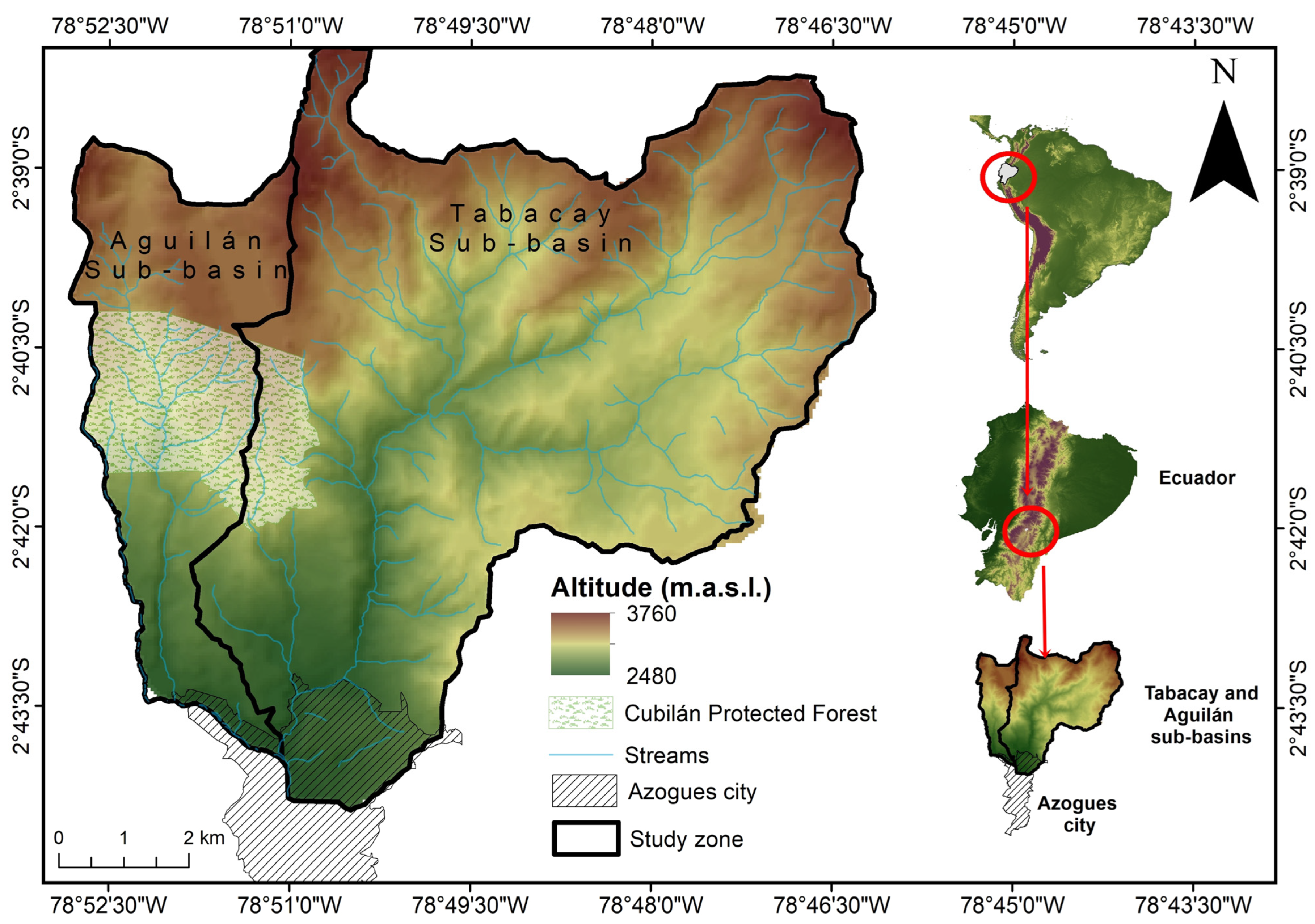
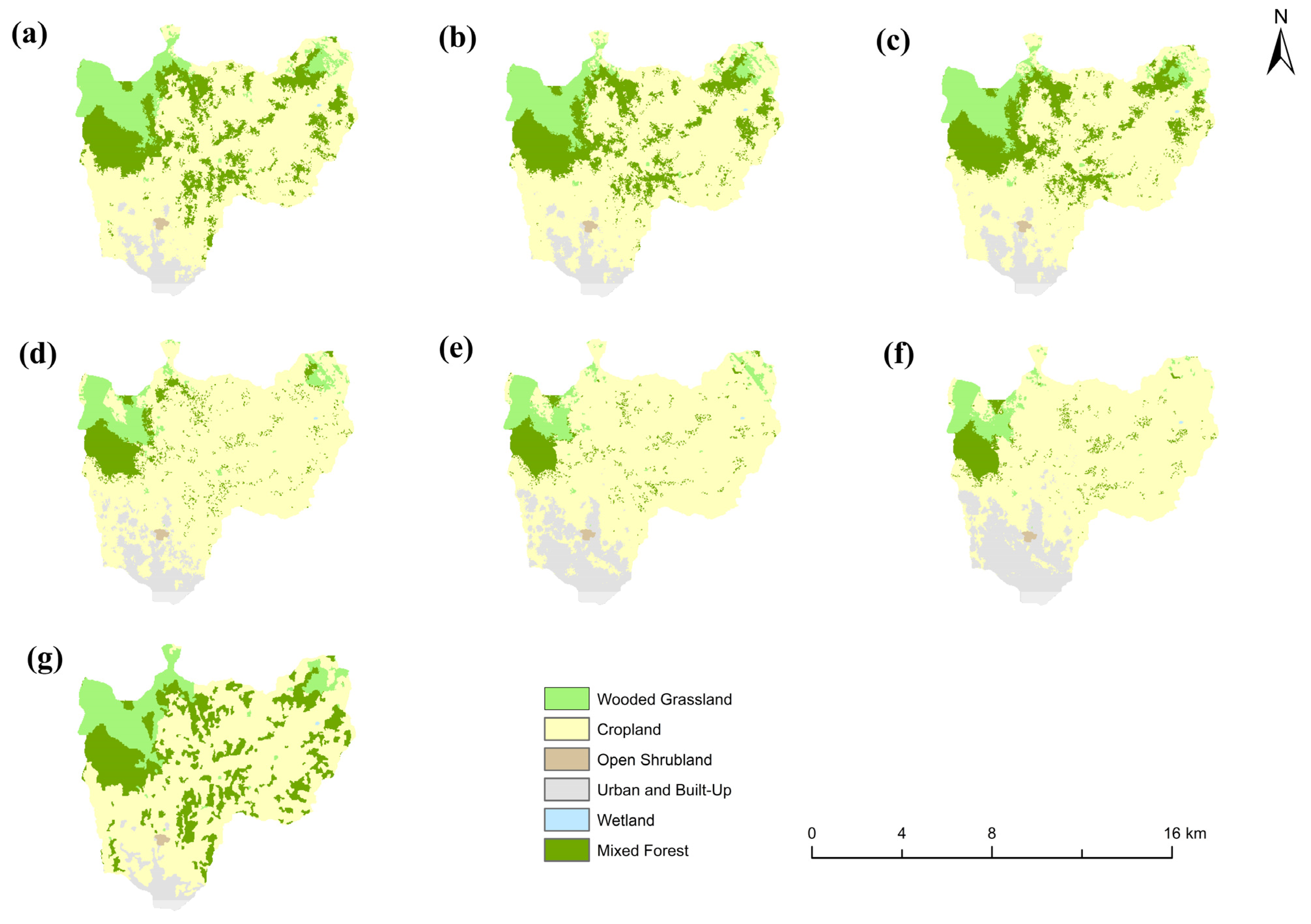

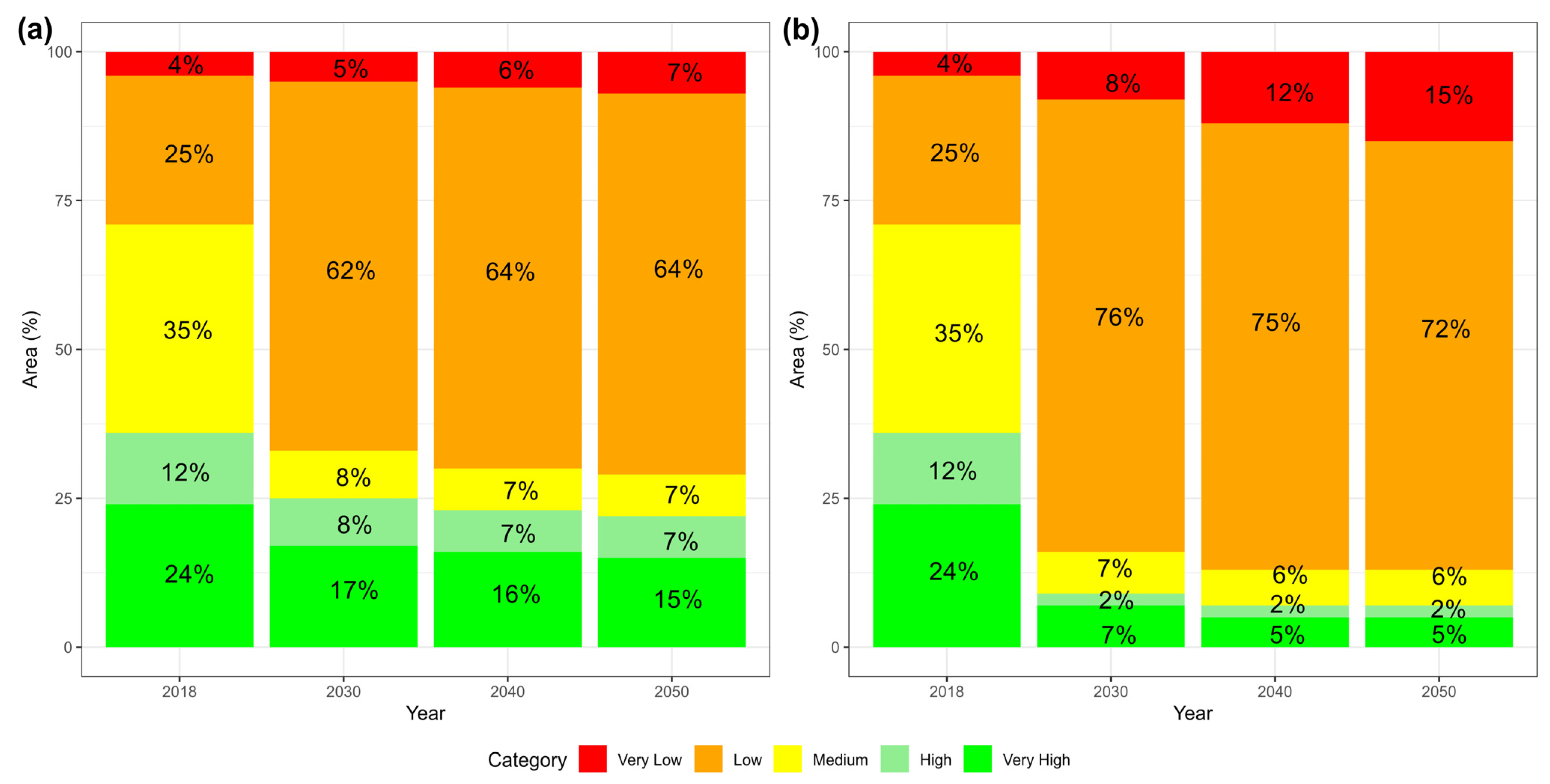
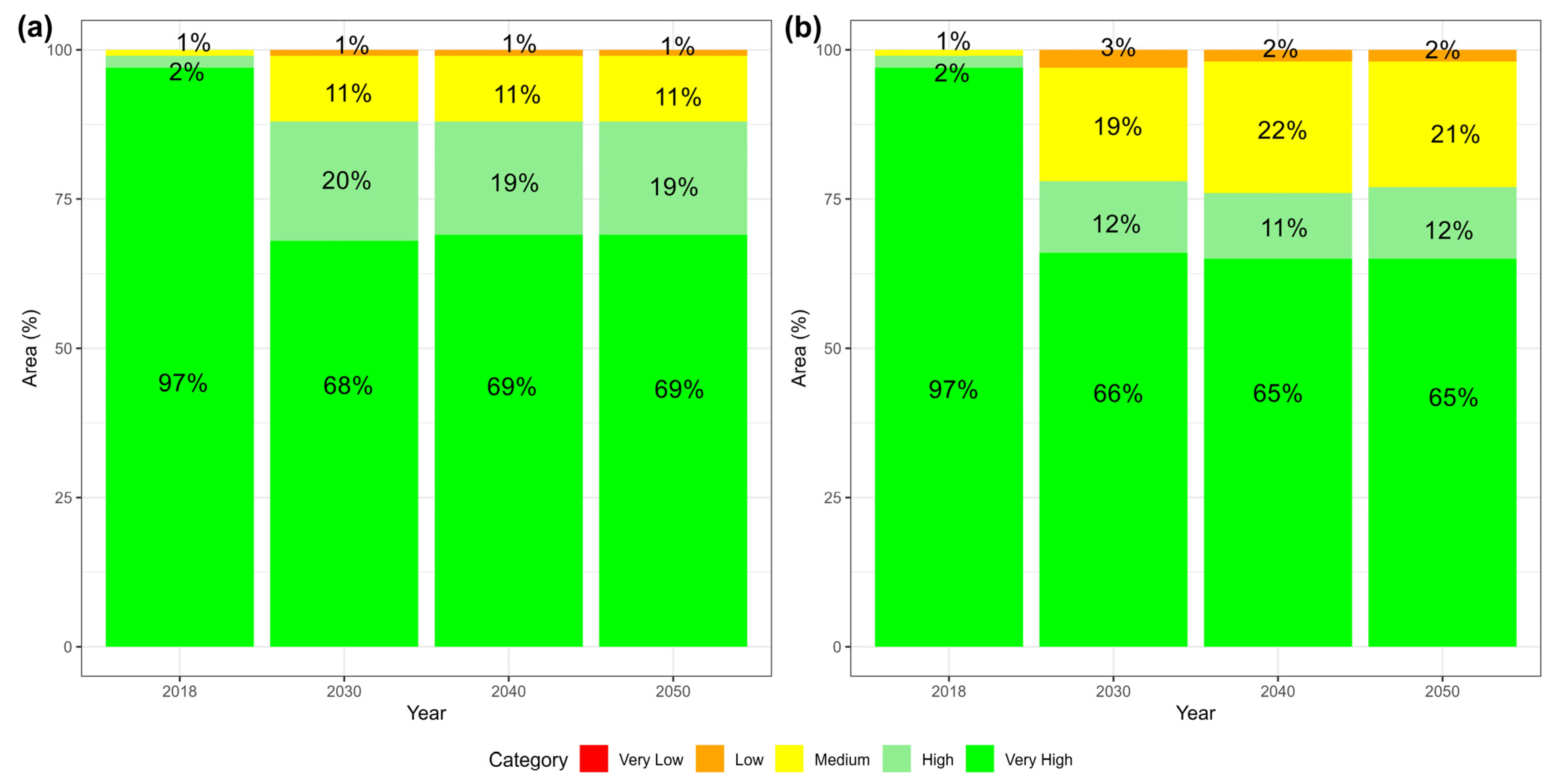
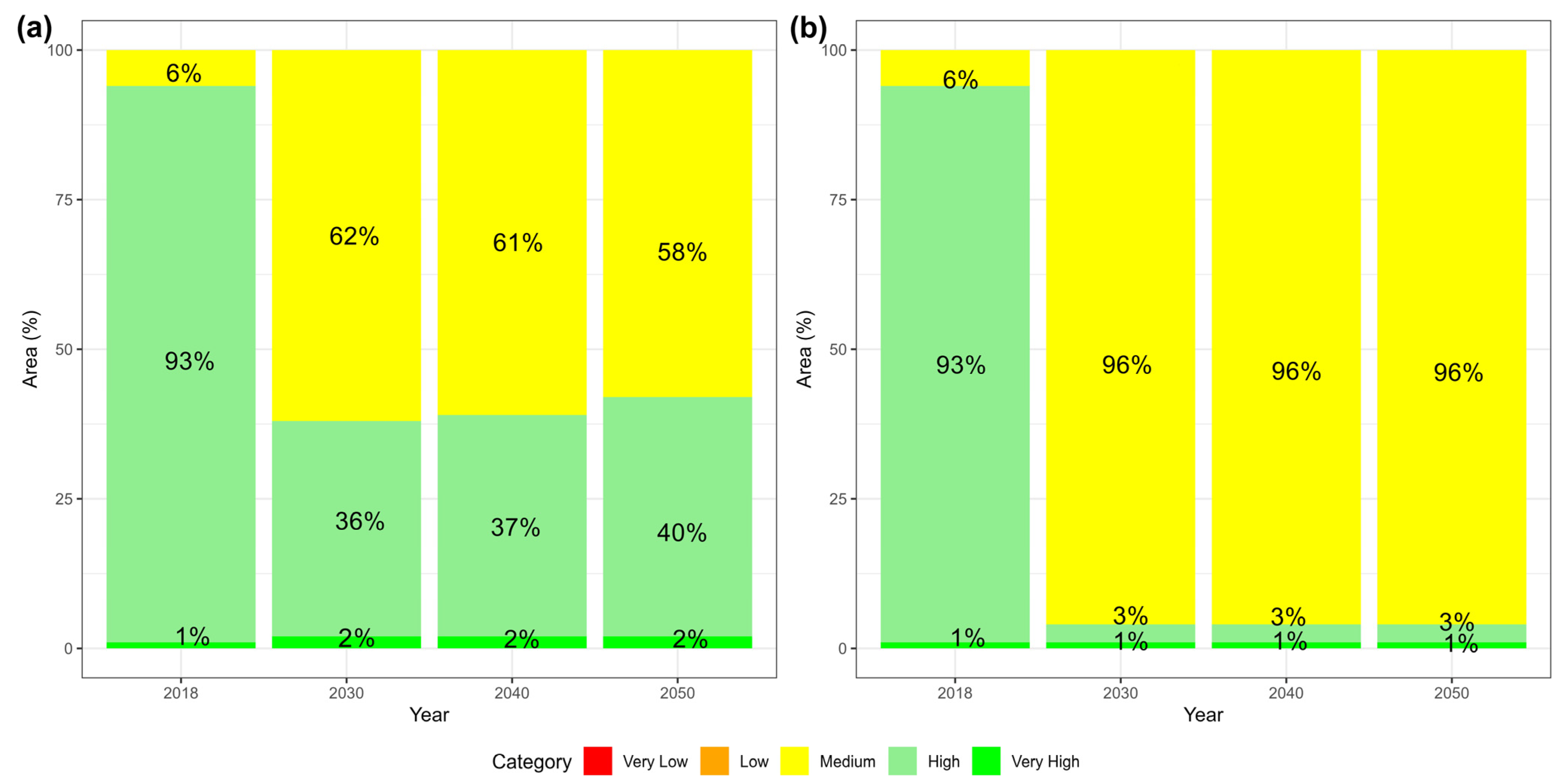
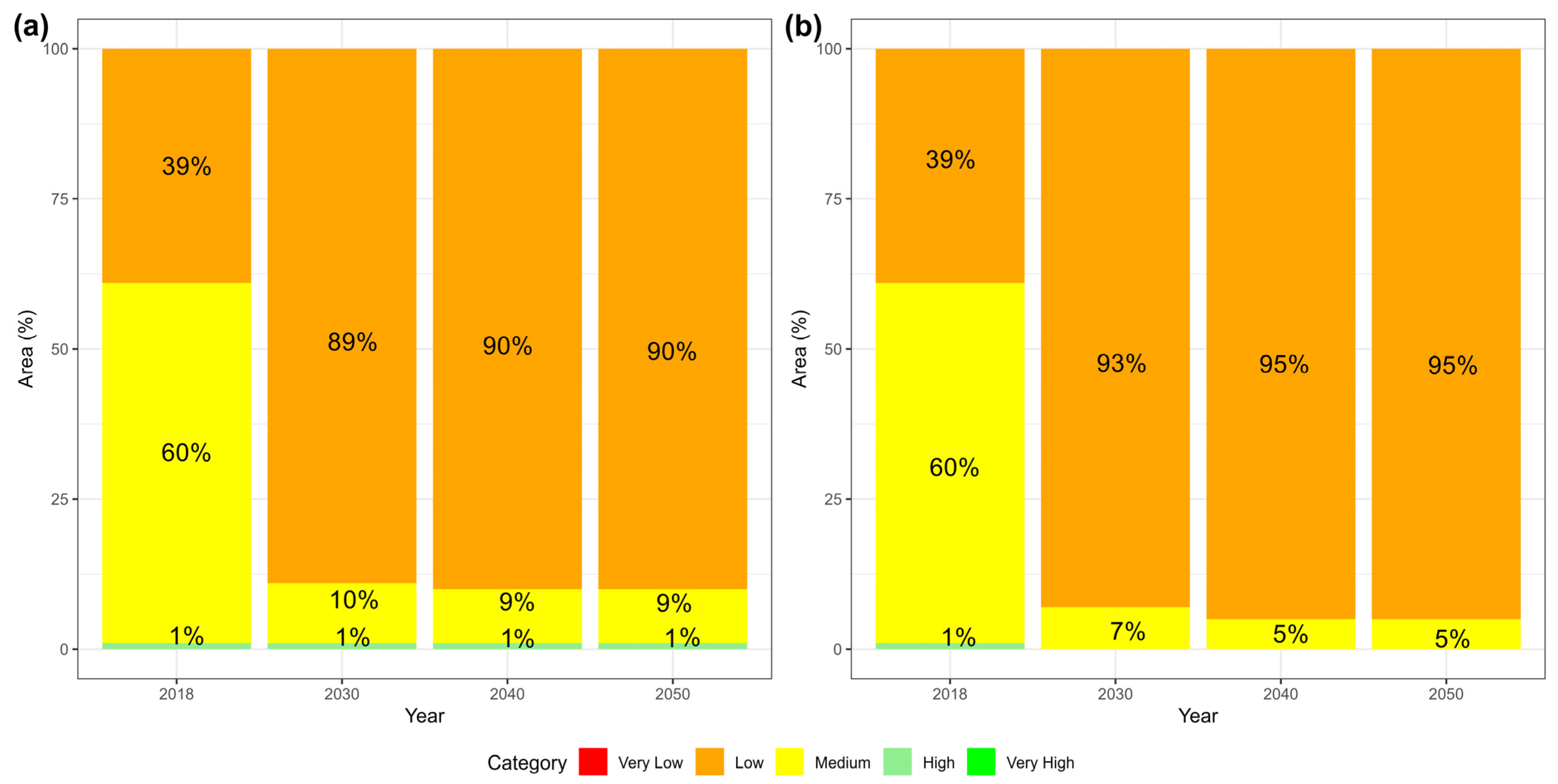

| Threats | Maximum Distance (km) | Weight | Spatial Decay Type |
|---|---|---|---|
| Cultivated land | 2.0 | 0.7 | linear |
| Urban land | 1.0 | 1.0 | exponential |
| Land Use | Habitat Suitability | Threats | |
|---|---|---|---|
| Cultivated Land | Urban Land | ||
| Wooded grassland | 0.8 | 0.4 | 0.7 |
| Cropland | 0.6 | 0.2 | 0.5 |
| Open shrubland | 0.1 | 0.1 | 0 |
| Urban and built up | 0 | 0 | 0 |
| Wetland | 0.9 | 0.5 | 0.8 |
| Mixed forest | 1.0 | 0.7 | 0.6 |
Disclaimer/Publisher’s Note: The statements, opinions and data contained in all publications are solely those of the individual author(s) and contributor(s) and not of MDPI and/or the editor(s). MDPI and/or the editor(s) disclaim responsibility for any injury to people or property resulting from any ideas, methods, instructions or products referred to in the content. |
© 2025 by the authors. Licensee MDPI, Basel, Switzerland. This article is an open access article distributed under the terms and conditions of the Creative Commons Attribution (CC BY) license (https://creativecommons.org/licenses/by/4.0/).
Share and Cite
González, L.; Zhiña, D.X.; Avilés, A.; Astudillo, A.; Peralta, X.; Verdugo, T. Exploring Habitat Quality Dynamics in an Equatorial Andean Basin Under Scenarios of Land Use Change. Earth 2025, 6, 10. https://doi.org/10.3390/earth6010010
González L, Zhiña DX, Avilés A, Astudillo A, Peralta X, Verdugo T. Exploring Habitat Quality Dynamics in an Equatorial Andean Basin Under Scenarios of Land Use Change. Earth. 2025; 6(1):10. https://doi.org/10.3390/earth6010010
Chicago/Turabian StyleGonzález, Lorena, Darío Xavier Zhiña, Alex Avilés, Ana Astudillo, Ximena Peralta, and Teodoro Verdugo. 2025. "Exploring Habitat Quality Dynamics in an Equatorial Andean Basin Under Scenarios of Land Use Change" Earth 6, no. 1: 10. https://doi.org/10.3390/earth6010010
APA StyleGonzález, L., Zhiña, D. X., Avilés, A., Astudillo, A., Peralta, X., & Verdugo, T. (2025). Exploring Habitat Quality Dynamics in an Equatorial Andean Basin Under Scenarios of Land Use Change. Earth, 6(1), 10. https://doi.org/10.3390/earth6010010






